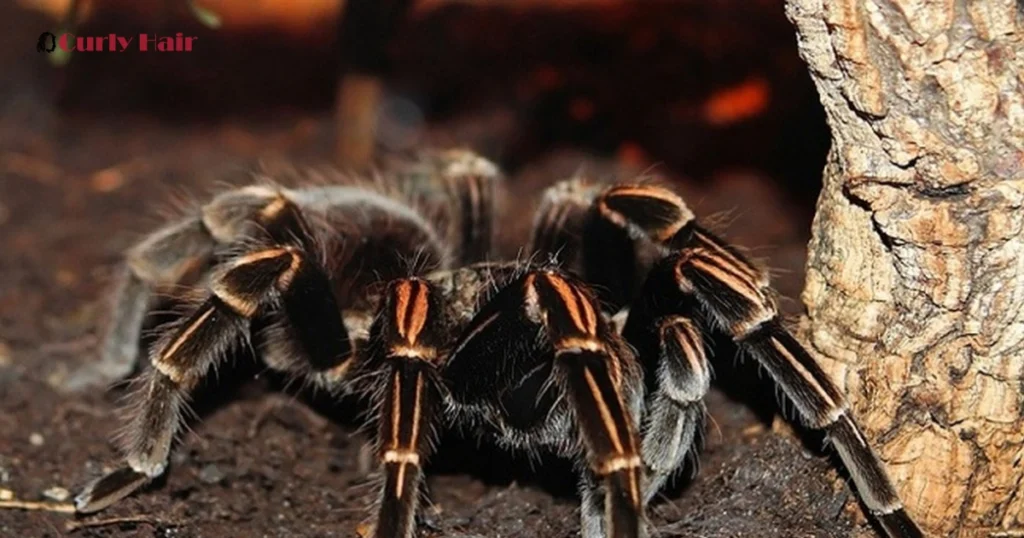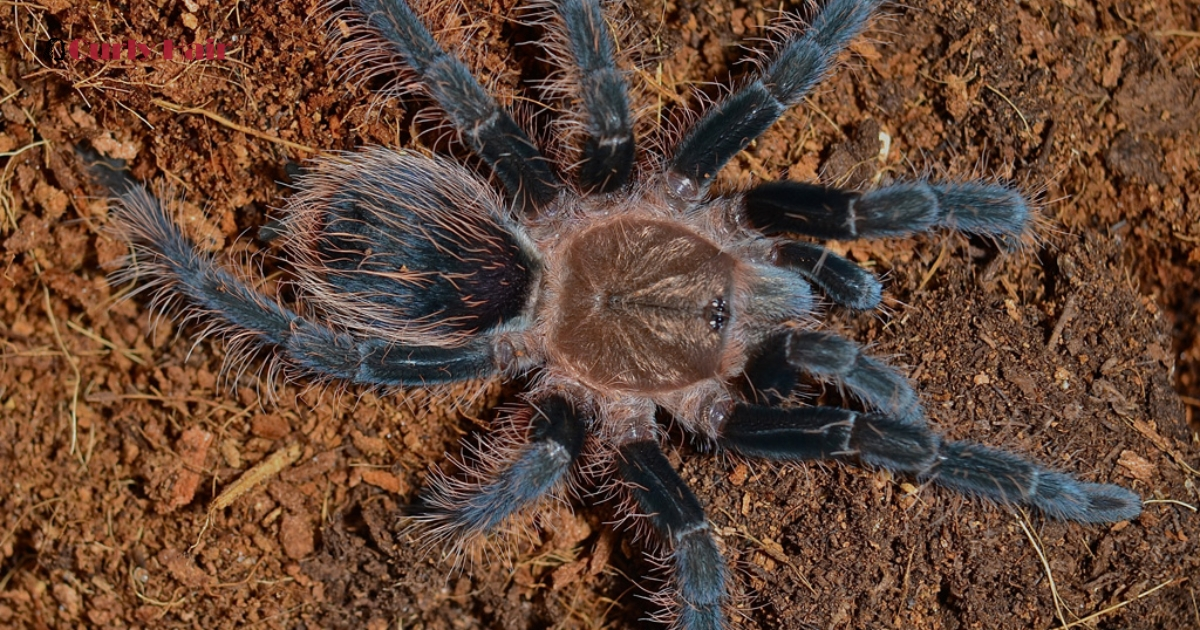Curly hair tarantulas, scientifically known as Brachypelma albopilosum, are one of the most popular species among tarantula enthusiasts. Recognized for their distinctive curly hair, dark brown color, and subtle bronze sheen, these spiders are native to Nicaragua and Costa Rica.
They are low-maintenance and relatively docile, making them an excellent choice for both beginners and experienced pet owners. In this guide, we’ll walk you through everything you need to know about caring for these fascinating creatures, from their habitat requirements to their behaviour and lifespan.
Key Takeaways
- Brachypelma albopilosum are known for their calm demeanor, making them ideal pets for beginners.
- They thrive in warm, humid environments with temperatures between 75°F and 80°F and humidity levels around 65-70%.
- Their diet consists mainly of live insects, such as crickets and roaches, with younger tarantulas needing more frequent feedings.
- Female curly hair can live up to 20 years, while males typically live around 5-7 years, making them a long-term commitment.
Identifying Characteristics of Curly Hair Tarantulas
| Characteristic | Description |
| Scientific Name | Brachypelma albopilosum |
| Coloration | Dark brown to black with distinctive curly, reddish-brown hairs (urticating hairs) |
| Size | Adult size ranges from 4 to 6 inches (10 to 15 cm) in leg span |
| Body Shape | A stocky and robust body with a broad carapace |
| Eyes | Eight small eyes arranged in a semi-circle on the front of the carapace |
| Legs | Long, hairy legs with a slight curvature, giving them a unique appearance |
| Molt Frequency | Young tarantulas molt more often; adults typically molt every 1-2 years |
| Temperament | Generally docile and non-aggressive, suitable for handling |
Curly hair that gives them their name. These hairs serve both functional and aesthetic purposes. When threatened, they use kicked hairs, more accurately referred to as urticating hairs, as a defense mechanism. By kicking these tiny, irritating hairs toward potential threats, they create a barrier that keeps predators at bay, making curly hair tarantulas friendly toward humans when handled with care.
Another distinct feature is their size. The average leg span of an adult curly hair tarantula can reach up to five to six inches, making them visually impressive. The slight bronze sheen that appears after they molt adds to their allure, especially when contrasted against their otherwise dark brown body.
There are also slight differences between the two main species Brachypelma albopilosum and Tliltocatl albopilosus. While both share the same curly hair trait, minor distinctions in behavior and appearance set them apart. It’s important to know which species you’re caring for to meet their specific needs.
Habitat Setup and Care Requirements

Creating a comfortable habitat for your curly hair tarantula is essential for their health and well-being. Since they are native to Nicaragua and Costa Rica, it’s important to replicate a tropical environment as closely as possible in their enclosure.
Enclosure Size and Setup
A 10-gallon tank works perfectly for one adult tarantula. The tank should be wider than it is tall because tarantulas are terrestrial creatures that prefer crawling over climbing. Be sure to include a piece of cork bark or similar items to serve as hiding spots. Tarantulas appreciate these hiding places, as they help them feel safe and secure.
Substrate
The bottom of the enclosure should be lined with a substrate that retains moisture well, such as coconut fiber or peat moss. A depth of at least 3-4 inches is recommended to allow the tarantula to burrow if desired.
Temperature and Humidity
Maintaining proper temperature and humidity levels is crucial. The ideal temperature for this species is between 75°F and 80°F (24°C – 27°C), with humidity levels around 65-70%. Use a heat mat to regulate the temperature if necessary, but avoid placing it directly under the tank to prevent overheating.
To maintain humidity, mist the enclosure lightly once or twice a week. Make sure there is a shallow water dish inside, which serves both as a drinking source and a way to help maintain humidity. Improper temperature and humidity levels can lead to health issues, including difficulties during molting.
Feeding and Behavior
These tarantulas are relatively easy to feed. They primarily consume live insects, such as crickets, roaches, and mealworms. It’s best to feed them every 7-10 days, depending on their size and age. Younger tarantulas require more frequent feeding than adults.
One of the reasons they are so popular is their calm demeanor. They are generally docile and slow-moving, making them less prone to aggressive behaviors. However, if they feel threatened, they may use their kicked hairs or adopt a defensive posture by raising their front legs. It’s important to handle them with care or avoid handling them altogether to prevent stress.
Lifespan Differences Between Males and Females
A notable aspect of this species is the difference in lifespan between males and females. Female tarantulas can live for up to 20 years with proper care. On the other hand, years males typically have a much shorter lifespan, often living only five to seven years. This is largely since males die shortly after reaching sexual maturity and breeding.
The Molting Process
Molting is an essential part of a tarantula’s life. During this process, they shed their old exoskeleton to grow. For young tarantulas, molting occurs more frequently, while adults molt once or twice a year. After molting, the bronze sheen on their growing curly hair becomes more pronounced, making them even more visually striking.
It’s crucial to provide the right conditions during molting. Ensure that the humidity levels are high enough to help them shed their exoskeleton without issues. Avoid feeding them during this time, as they are vulnerable and need time to harden their new exoskeleton.
Species Variants and Geographic Differences

While Brachypelma albopilosum is the most common species of curly hair tarantula, some enthusiasts may encounter Tliltocatl albopilosus, another variant with slight differences in appearance and behavior. Brachypelma albopilosum is generally more docile, making it a better choice for beginners.
Both species are native to the tropical forests of Nicaragua and Costa Rica, where they thrive in humid environments. These regions are home to many different tarantula species, but the curly hair stands out for its unique appearance and calm temperament.
Common Health Issues
These tarantulas are relatively hardy creatures, but they can face health problems if their habitat is not properly maintained. The most common issues stem from incorrect temperature and humidity levels. If the enclosure is too dry, the tarantula may struggle with molting and other health concerns.molting, which can lead to life-threatening complications. On the other hand, too much humidity can encourage mold growth, which poses a health risk.
Ensure that your tarantula has enough space and hiding spots to reduce stress. Overhandling can also stress the tarantula, weakening its immune system and making it more prone to infections.
Frequently Asked Question
How venomous are these tarantulas?
Their venom is mild and typically comparable to a bee sting, causing minor pain or irritation in most cases. While their bite is not dangerous to humans
Do these tarantulas enjoy being held?
Like many other species of tarantulas, generally do not enjoy being held. While they can become accustomed to human interaction over time, they are not social creatures and may feel stressed or threatened when handled.
Are these tarantulas suitable for beginners?
Yes, these tarantulas are excellent pets for beginners due to their docile nature and low maintenance needs. Their calm temperament and simple care requirements make them ideal for those new to tarantula keeping.
How big does a curly hair tarantula get?
They typically reach a leg span of about 4 to 6 inches as adults, with females often larger than males some growing up to 6.5 inches. Their robust bodies and curly setae give them a unique appearance, contributing to their popularity among tarantula enthusiasts.
Conclusion
Curly hair tarantulas are an excellent choice for anyone interested in keeping a tarantula as a pet. Their calm demeanor, manageable care requirements, and unique appearance, marked by curly hair, dark brown coloring, and a bronze sheen, make them a favorite among hobbyists.
By providing the right environment, paying attention to temperature and humidity, and respecting their natural behaviors, you can enjoy the company of these fascinating creatures for many years. Whether you’re just starting your tarantula-keeping journey or you’re a seasoned enthusiast, the curly hair tarantula is sure to be a rewarding pet.











